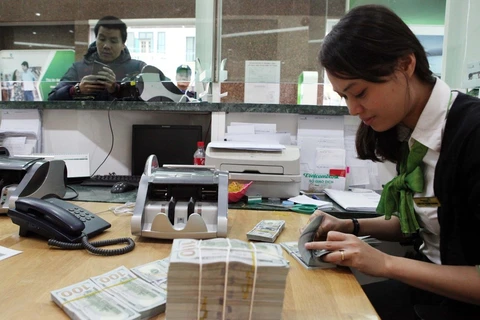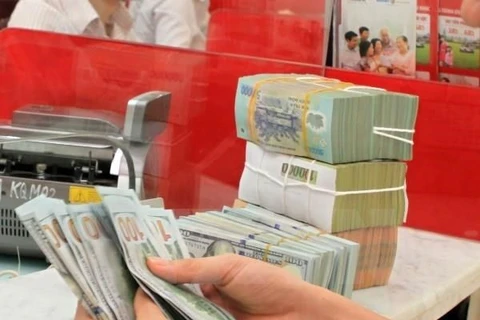Hanoi (VNA) – The State Bank of Vietnam held its interest rates steady, and signaled it plans to stay hold until the end of 2019. A further drop would depend on local macro-economic situation and economic indexes, according to Deputy Governor of the State Bank of Vietnam (SBV) Dao Minh Tu.
 Deputy Governor of the State Bank of Vietnam Dao Minh Tu speaks at the press conference. (Photo: VietnamPlus)
Deputy Governor of the State Bank of Vietnam Dao Minh Tu speaks at the press conference. (Photo: VietnamPlus)
Interest rates kept stable
In mid-September, the SBV decided to cut several key interest rates by 0.25 percentage points to boost liquidity of the financial institutions, helping prop up the economic growth.
A cut in interest rates means the SBV stands ready to support local businesses, particularly in the last months of the year, according to Tu.
He held that several financial institutions such as state-owned commercial banks and large commercial joint stock banks lowered their lending rates for prioritised investment sectors in the beginning of the year. The SBV also adjusted its interest rate cap so that the institutions can access the capital at rational costs.
Currently, the deposit rates range from 0.5 – 1 percent for non-term deposits and under-one-month deposits, 4.5 – 5.5 percent for deposits from one- to six-month term, 5.5 – 6.5 percent for deposits having 6 – 12 month term, and 6.6 – 7.3 percent for deposit from 12-month term. Meanwhile, lending rates hover around 6 - 9 percent for short-term lending, and 9 – 11 percent for medium- and long-term lending.
VND remains broadly stable against USD
The central bank has maintained a flexible management of the exchange rate, which moves in tandem with the financial market situation, macro-economic balances and monetary policies.
Director General of the Monetary Policy Department under the SBV Pham Thanh Ha said that despite intense pressure from the global market, the foreign exchange rate remains stable.
The central bank’s USD/VND reference exchange rate increased about 1.5 percent from the outset of the year, he added.
At the press briefing, many said that it is necessary to devaluate the VND against the greenback to bolster exports. However, the SBV Deputy Governor explained that making the local currency weaker or stronger depends much on the economic situation, and the management policy must be adjusted rationally for a more stable market.
Export slump has been driven by a wide range of headwinds in the global market, he stressed.
“The National Financial and Monetary Policy Advisory Council described the SBV’s foreign exchange policy suitable with current economic situation. The central bank needs to consider measures to stablise the macro-economy, and it could not see exchange rate as an effective tool to promote exports,” Tu added.
VND was expected to remain broadly stable against the USD over the remainder of 2019 and to be slightly weaker on average over 2020, buoyed by robust foreign direct investment (FDI) inflows, dollar purchases by businesses, and a healthy foreign reserve position, experts have forecast.
"The VND will remain stable as FDI inflows are expected to remain strong over the coming months with an early solution to the US - China trade war unlikely. Businesses will probably continue shifting part of their supply chains out of China to the rest of Asia, and Vietnam is expected to be a strong beneficiary of this move given its positive business environment, many free trade agreements, and a low cost, large and relatively young labour force," finance expert Nguyen Tri Hieu said.
According to Hieu, the bulk of FDI flowing into Vietnam remained in the manufacturing sector due to the relocation of supply chains, although rising demand for infrastructure would also create opportunities and thus lure FDI into the infrastructure and construction industry over the coming months.
Hieu also believed a burgeoning middle class on the back of rapid economic growth would also continue to attract FDI into the retail sector. During the first nine months of 2019, the total FDI increased by 3.3 per cent over the same period in 2018 to 26.2 billion USD, of which wholesale and retail accounted for 1.4 billion USD.
Meanwhile, strong prior inflows of FDI into the manufacturing sector as well as Vietnam’s position in the global supply chain were expected to increase the country’s imports in tandem with its exports. Given that global trade is mainly transacted in USD, this points towards an increase in USD demand among businesses.
As a result, domestic firms will likely increase purchases of the USD over the coming months. Meanwhile, as part of a regulatory amendment announced in August, commercial banks will no longer provide mid- and long-term foreign currency loans for payment of imported goods and services. The amendment aims to reduce the dollarisation in the economy and to improve the interest rate transmission of monetary policy. Under the new regulation, local importers will have to borrow in VND and buy USD to fulfill overseas payment obligations.
In addition, experts said the nation’s good foreign reserves would also help stabilise the VND in the coming months. The latest data showed Vietnam’s foreign reserves at 63.9 billion USD in May, representing three months of import cover.
Can Van Luc, Chief Economist at the Bank for Investment and Development of Vietnam, believed the SBV had sufficient foreign exchange reserves to continue its course of active intervention to ensure currency stability, which suggests the VND would likely see minimal volatility over the coming months./.























